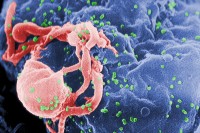HIV (Human Immunodeficiency Virus) is a virus that attacks the human immune system and can lead to a diagnosis of AIDS (Acquired Immune Deficiency Syndrome). Every person with an AIDS diagnosis has HIV, but not everyone with HIV has AIDS.
HIV attacks specific immune system cells — the T-cells or CD4 cells. These cells are critical to fighting off new infections and diseases. HIV invades these cells and uses them to make more copies of itself, and then destroys them. Over time, HIV destroys so many cells that the body is not able to fight off diseases and infections. When this occurs, a person is given an AIDS diagnosis.
There is no cure for HIV. But, this disease is preventable. By
However, with proper treatment with “antiretroviral therapy” many people living with HIV can live longer and healthier lives.
HIV (Human Immunodeficiency Virus) is transmitted only through four fluids:
- Blood
- Semen (including pre-cum)
- Vaginal fluids
- Breast milk
Transmission of HIV can only occur when an HIV-infected body fluid enters the body through a port of entry (examples: vagina, anus, veins, mouth, direct access to tissue).
You cannot get HIV through touching, kissing, sharing food or beverages, or being friends with someone who is HIV positive.
Safer sex practices are ways to reduce the risk of becoming HIV positive. These include using barrier methods, knowing the HIV status of your partner, minimizing higher risk sexual and/or drug use behaviors, and getting tested for HIV and other STIs.
Safer injection practices are ways to reduce the risk of becoming HIV positive through needles. These include using clean needles and works every time you inject and getting tested for HIV and Hepatitis C.
HIV (Human Immunodeficiency Virus) is transmitted only through four fluids:
- Blood
- Semen (including pre-cum)
- Vaginal fluids
- Breast milk
Transmission of HIV can only occur when an HIV-infected body fluid enters the body through a port of entry (examples: vagina, anus, veins, mouth, direct access to tissue).
You cannot get HIV through touching, kissing, sharing food or beverages, or being friends with someone who is HIV positive.
Safer sex practices are ways to reduce the risk of becoming HIV positive. These include using barrier methods, knowing the HIV status of your partner, minimizing higher risk sexual and/or drug use behaviors, and getting tested for HIV and other STIs.
Safer injection practices are ways to reduce the risk of becoming HIV positive through needles. These include using clean needles and works every time you inject and getting tested for HIV and Hepatitis C.

